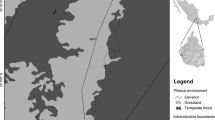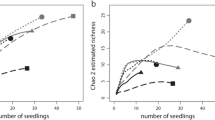Abstract
We investigated if Pinus ponderosa plantations in Patagonia are able to produce viable mycorrhizal inocula towards adjacent grasslands, which only harbor endomycorrhizal vegetation. We hypothesized that these inocula have the potential to contribute to the establishment of naturally disseminated seedlings. Also, we determined the main fungal taxa involved in this process. Seven plantations in the onset of their reproductive phase and located in the Patagonian native forest/steppe ecotone (Argentina) were selected. Soil samplings were obtained at nine points along a 450 m long, W-E transect established in each plantation. Soil bioassays were performed in a greenhouse, with P. ponderosa seedlings acting as hosts for mycorrhizal inocula present in soil samples, during 12 months. Mycorrhization percentage, morphotype richness and morphotype composition was determined through morphological evaluation. Viable ecto- and ectendomycorrhizal inocula were found disseminated outside plantations. The amount of mycorrhizal inoculum followed a decreasing function with distance to plantation edges. Mycorrhizal fungal genus Rhizopogon and “E-strain” mycorrhizal types appeared as pioneering taxa regarding seedlings colonization, being the most persistent and frequent symbionts found. Plantations, thus, facilitate the surrounding terrain for newcoming seedlings through the dispersion of mycorrhizal fungal inocula.




Similar content being viewed by others
References
Andematten E, Gonda HE, Letorneau F, Cortez GO, Bava JO (2002) Proyección de la distribución diamétrica en plantaciones de pino ponderosa en la provincia de Neuquén. Informe final. Proyecto PIA 15/58; SAGPyA. Argentina
Barroetaveña C (2004) Estudio de las Ectomicorrizas de plantines y plantaciones de pino ponderosa (Pinus ponderosa.) y pino oregón (Pseudotsuga menziesii) en la región Andino Patagónica. Tesis para optar al título de Doctor en Ciencias Biológicas, Universidad Nacional del Comahue, Centro Regional Universitario Bariloche, San Carlos de Bariloche, Octubre de 2004
Barroetaveña C, Rajchenberg M (2003) Las micorrizas y la producción de plántulas de Pinus ponderosa Dougl. & Laws. en la Patagonia Argentina. Bosque 24:17–33
Barroetaveña C, Rajchenberg M, Cázares E (2005) Mycorrhizal fungi in Pinus ponderosa introduced in Central Patagonia (Argentina). N Hedw 80:453–464
Barroetaveña C, Cázares E, Rajchenberg M (2007) Ectomycorrhizal fungi associated with ponderosa pine and Douglas-fir: a comparison of species richness in native western North America and Patagonian plantations from Argentina. Mycorrhiza 17:355–373
Broquen P, Giradin J, Frugoni M (1995) Evaluación de algunas propiedades de suelos derivados de cenizas volcánicas asociadas con forestaciones de coníferas exóticas (S. O. de la Provincia de Neuquén-R. Argentina). Boques 16:69–79
Brundrett M, Bougher N, Grove T, Malajczuk N (1996) Working with mycorrhizas in forestry and agriculture. Austral Cent Int Agric Res, Mon n° 32. Canberra
Bruns TD, Peay KG, Boynton PJ, Grubisha LC, Hynson NA, Nguyen NH, Rosenstock NP (2009) Inoculum potential of Rhizopogon spores increases with time over the first 4 year of a 99-year spore burial experiment. New Phytol 181:463–470
Cabrera AL, Willink A (1980) Biogeografía de América Latina. Serie de Biología, Monografía 13. The General Secretariat of the Organization of American States, Washington
Cázares E, Smith JE (1996) Occurrence of vesicular-arbuscular mycorrhizae in Pseudotsuga menziesii and Tsuga heterophylla seedlings grown in Oregon Coast Range soils. Mycorrhiza 6:65–67
Colmet Dâage F, Marcolin A, López C, Ayesa J, Brand D, Andematten E, Broquen P, Giradin J, Córtes G, Irrisarri J, Besoain E, Sadzawka A, Sepúlveda G, Massaro S, Millot G, Bouleau P (1988) Caraterísticas de los suelos derivados de cenizas volcánicas de la cordillera y precordillera del norte de la Patagonia. Bariloche Convenio INTA-ORSTOM. S.C. de Bariloche, Rio Negro, p 167
Fontenla S, Godoy R, Rosso P, Havrylenko M (1998) Root associations in Austrocedrus forests and seasonal dynamics of arbuscular mycorrhizas. Mycorrhiza 8:29–33
Goodman DM, Durall DM, Trofymow JA (eds) (1996) Concise descriptions of North American Ectomycorrhizae. Mycologue publications & Canade-B.C. Forest Res Dev Agreement. Can For Serv. Victoria
Grotkopp E, Rejmánek M, Rost TL (2002) Toward a casual explanation of plant invasiveness: seedling growth and life history strategies of 29 pine (Pinus) species. Am Nat 159:396–419
Horton TR, Cázares E, Bruns TD (1998) Ectomycorrhizal, vesicular-arbuscular and dark septate fungal colonization of boshop pine (Pinus muricata) seedlings in the first 5 months of growth after wildfire. Mycorrhiza 8:11–18
Izzo A, Nguyen DT, Bruns TD (2006) Spatial structure and richness of ectomycorrhizal fungi colonizing bioassay seedlings from resistant propagules in a Sierra Nevada forest: comparisons using two hosts that exhibit different seedling establishment patterns. Mycologia 98:374–383
Kjøller R, Bruns TD (2003) Rhizopogon spore bank communities within and among California pine forests. Mycologia 95:603–613
Kovacic DA, St Johan TV, Dyer MI (1984) Lack of vesicular-arbuscular mycorrhizal inoculum in a ponderosa pine forest. Ecology 65:1755–1759
Kranabetter JM, Wylie T (1998) Ectomycorrhizal community structure across forest openings on naturally regenerated western hemlock seedlings. Can J Bot 76:189–196
Kropp BR, Langlois CG (1990) Ectomycorrhizae in reforestation. Can J For Res 20:438–451
López C (1996) La carta de los suelos en apoyo a la evaluación del potencial forestal de las tierras de la Región Andina Patagónica Norte. Suelos. Utilización de la cartografía para el uso sustentable de las tierras. In: Moscatelli GN, Panigatti J, Di Giacomo RM (eds) Programa Nacional de Suelos. Subprograma de Reconocimiento de Suelos. INTA-SAPyA, pp 78–91
Marx DH, Cordell CE (1989) The use of specific ectomycorrhizas to improve artificial forestation practices. In: Whipps JM, Lumdsen RD (eds) Biotechnology of fungni for improving plant growth. Chapter 1. Cambridge University Press, New York
Mikola P (1988) Ectendomycorrhiza of conifers. Silva Fenn 22:19–27
Miller SL, Torres P, McClean TM (1994) Persistence of basidiospores and sclerotia of ectomycorrhizal fungi and Morchella in soil. Mycologia 86:89–95
Molina R, Trappe JM, Grubisha LC, Spatafora JW (1999) Rhizopogon. In: Cairney JW, Chambers SM (eds) Ectomycorrhizal fungi, key genera and profile. Springer Verlag, Berlin
Nuñez MA, Horton TR, Simberloff D (2009) Lack of belowground mutualisms hinders Pinaceae invasions. Ecology 90(9):2352–2359
Oliver WW, Ryker RA (1991) Pinus ponderosa. In: Burns RM, Honkala BH (eds) Silvics of North America, vol 1, Conifers. Agriculture Handbook 654, Forest Service, USA
Ortiz E (1976) Materia orgánica y nitrógeno en suelos de Patagonia. IDIA Suplemento 33:79–83
Pardiñas UFJ, Teta PA, Cirignoli S, Podestá DH (2003) Micromamíferos (Didelphimorphia y Rodentia) de Norpatagonia Extra Andina, Argentina: Taxonomía Alfa y Biogeografía. Mastozoología Neotropical 10(1):69–114
Pearson OP (1995) Annotated keys for identifying small mammals living in or near Nahuel Huapi National Park or Lanin National Park, southern Argentina. Mastozoología Neotropical 2(2):99–148
Reinhart KO, Callaway RM (2006) Soil biota and invasive plants. New Phytol 170(3):445–457
Richardson DM, Williams PA, Hobbs RJ (1994) Pine invasions in the Southern Hemisphere: determinants of spread and invadability. J Biogeogr 21:511–527
Richardson DM, Allsopp N, D’Antonio C, Milton SJ, Rejmánek M (2000) Plant invasions—the role of mutualisms. Biol Rev 75:65–93
Richardson DM, van Wilgen BW, Nuñez MA (2008) Alien conifer invasions in South America: short fuse burning? Biol Invasions 10:573–577
Salazar Lea Plaza JC, Godagnone RE, Pappalardo JE (1990) Provincia del Chubut. In: Moscatelli G (ed) Atlas de suelos de la República Argentina. SAGPyA-INTA- Proyecto PNUD ARG/85/019
Sarasola MM, Rusch VE, Schlichter TM, Ghersa CM (2006) Invasión de coníferas forestales en áreas de estepa y bosque de ciprés de la cordillera en la región Patagónica. Ecol Austral 16:143–156
Servicio Meteorologico Nacional (2001) http://www.mineria.gov.ar\estudios\irn. Accessed 30 Aug 2009
Simberloff D, Relva MA, Nuñez M (2002) Gringos en el bosque: introduced tree invasion in a native Nothofagus/Austrocedrus forest. Biol Inv 4:35–53
Smith FA, Read DJ (2008) Mycorrhizal symbioses. Academic Press, Cambridge
Smith JE, Johnson KS, Cázares E (1998) Vesicular mycorrhizal colonization of seedlings of Pinaceae and Betulaceae after spore inoculation with Glomus intraradices. Mycorrhiza 7:279–285
Steel RGD, Torrie JH (1988) Bioestadística: Principios y Procedimientos. Mc Graw-Hill, México
Steinauer EM, Bragg TB (1987) Ponderosa pine (Pinus ponderosa) invasion of Nebraska sandhills prairie. Am Midl Nat 118:358–365
Thiet RK, Boerner REJ (2007) Spatial patterns of ectomycorrhizal fungal inoculum in arbuscular mycorrhizal barrens communities: implications for controlling invasion by Pinus virginiana. Mycorrhizae 17:507–517
Wardle DA, Bargett RD, Klironomos JN, Setälä H (2004) Ecological linkages between aboveground and belowground biota. Science 304:1629–1633
Willan RL (1991) Guía para la manipulación de las semillas forestales, con especial referencia a los trópicos. Estudio FAO. Monte 20/2
Yu TEJC, Egger KN, Peterson RL (2001) Ectomycorrhizal associations-characteristics and functions. Mycorrhiza 11:167–177
Acknowledgments
We are grateful to owners and plantation keepers for allowing us to work in their properties. Technician Juan Monges was most helpfull for all field work done. M. Pasquini (Seed Laboratory, Centro Forestal CIEFAP and UNPSJB University) kindly provided the seeds for this study. Funding from project UNPSJB n°780 is greatly acknowledged. Dr. Efren Cázares (Oregon State University, OR, USA) kindly reviewed the English text. We acknowledge two anonymous reviewers for suggesting improvements in the manuscript. MESS is fellow and CB and MR are researchers for the National Research Council of Argentina (CONICET).
Author information
Authors and Affiliations
Corresponding author
Rights and permissions
About this article
Cite this article
Salgado Salomón, M.E., Barroetaveña, C. & Rajchenberg, M. Do pine plantations provide mycorrhizal inocula for seedlings establishment in grasslands from Patagonia, Argentina?. New Forests 41, 191–205 (2011). https://doi.org/10.1007/s11056-010-9220-1
Received:
Accepted:
Published:
Issue Date:
DOI: https://doi.org/10.1007/s11056-010-9220-1




